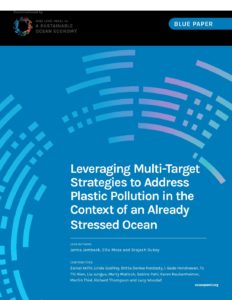Leveraging Multi-Target Strategies to Address Plastic Pollution in the Context of an Already Stressed Ocean

Author:
Jenna Jambeck, Ellie Moss, Brajesh Dubey, Zainal Arifin, Linda Godfrey, Britta Denise Hardesty, I. Gede Hendrawan, To Thi Hien, Liu Junguo, Marty Matlock, Sabine Pahl, Karen Raubenheimer, Martin Thiel, Richard Thompson, and Lucy Woodall
Publication Year:
2020
Citation:
Jambeck, J., E. Moss, B. Dubey et al. 2020. Leveraging Multi-Target Strategies to Address Plastic Pollution in the Context of an Already Stressed Ocean. Washington DC: World Resources Institute. Available online at: https://oceanpanel.org/blue-papers/pollution-and-regenerative-economy-municipal-industrialagricultural- and-maritime-waste.
Description:
The ocean is the ultimate sink for anthropogenic pollution. According to the HydroSHED model, over 80 percent of the land mass on Earth is in a watershed that drains directly to the ocean (Lehner and Grill 2013). Until recently, the ocean seemed to be endlessly able to absorb all the waste that human activity has discharged into it. The Ocean Health Index (OHI) scores the health of the ocean on a range of criteria, from how clean the water is to the ability of the ocean to continue providing services such as food provision, carbon storage, tourism and recreation, and biodiversity (Halpern et al. 2012). The 2019 combined global ocean score was 71 out of 100 (as it has been for the last five years), showing that significant impairment has occurred, but that many of the functions and services of the ocean remain and must be better managed (OHI 2019). The Clean Water section of the OHI includes details on the statuses and pressures of chemical, nutrient, pathogen and trash pollution. It also includes social pressure as a further pressure. Indicators of resilience were based upon the Convention on Biological Diversity (in particular for marine ecosystems) and quality of governance (using Worldwide Governance Indicators). The score for Clean Water has tracked closely to the overall score, remaining at 70 for the past five years (OHI 2019). With an estimated 91 percent of all temperate and tropical coasts predicted to be heavily developed by 2050 (Nellemann et al. 2008), this is a critical time to significantly reduce and prevent anthropogenic pollution to the ocean.
See related content:
- Explore the site by related topics: Pollution and Development, Solutions
